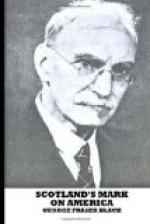century. George Murray, born in Scotland, died
in Philadelphia in 1822, organized the bank-note and
engraving firm of Murray, Draper, Fairman & Co., in
1810-11, the best note engravers in this country in
their day. John Vallance, also born in Scotland,
died in Philadelphia in 1823, was one of the founders
of the Association of Artists in America, and Treasurer
of the Society of Artists in Philadelphia in 1810.
James Smillie (1807-85), born in Edinburgh, died in
New York, was celebrated as an engraver of bank notes
and as an engraver of landscapes. Among his best
works are Cole’s series “The Voyage of
Life,” and Bierstadt’s “Rocky Mountains.”
Dr. Alexander Anderson (1775-1870), the “Bewick
of America,” born in New York of Scots parentage,
at the age of ninety-three engraved some illustrations
for Barbour’s “Historical Collections
of New Jersey.” Robert Hinschelwood, born
in Edinburgh in 1812, studied under Sir William Allen,
was landscape engraver for Harpers and other New York
publishers and also engraver for the Continental Bank
Note Company. John Geikie Wellstood, born in
Edinburgh in 1813, was another eminent engraver.
In 1858 his firm was merged in the American Bank Note
Co., and in 1871 he founded the Columbian Bank Note
Company of Washington, D.C. He also made many
improvements in the manufacture of banknotes.
Charles Burt (c. 1823-92), born in Edinburgh, died
in Brooklyn, a pupil of William Home Lizars of Edinburgh,
did some fine plates and portraits for books and for
several years was one of the chief engravers for the
Treasury Department in Washington. Hezekiah Wright
Smith, born in Edinburgh, in 1828, engraved portraits
of Daniel Webster, Edward Everett, and his head of
Washington, after the Athenaeum head by Gilbert Stuart,
is said to be “the best engraving of this famous
portrait ever made.” Nathaniel Orr (b.
1822), of Scottish ancestry, retired in 1888 “with
the reputation of having brought the art of wood engraving
to the highest perfection, and the signature ‘Orr,’
cut in the block was always a sure guarantee of art
excellence.” Robert Shaw, born in Delaware
in 1859 of Scottish parentage, has made a reputation
by his etchings of famous historical buildings.
His etching, the “Old Barley Mill” ranks
as one of the best etchings made in this country.
A few other Scottish engravers who produced good work
were Robert Campbell, William Charles (d. Philadelphia,
1820), Alexander L. Dick (1805), W.H. Dougal
(he dropped the “Mac” for some reason),
Helen E. Lawson (daughter of Alexander Lawson already
mentioned), John Roberts (1768-1803), William Main
Smillie (1835-88), son of James Smillie mentioned
above, and William Wellstood (1819-1900).




